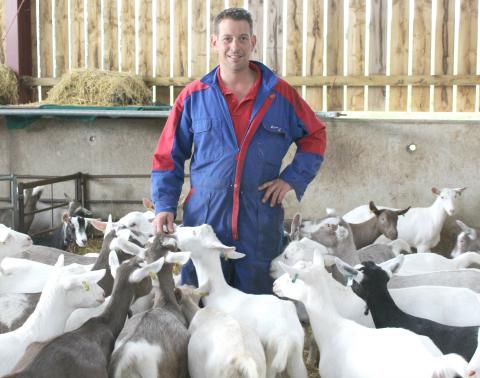Keeping mortality rates down and growth rates up is one of the main targets for commercial milking goat producers looking to improve productivity and efficiency.
At a Farming Connect meeting held at Pant Farm, Llanvetherine, Abergavenny, established and new producers discussed strategies for improving efficiency in goat rearing. Host farmer Gary Yeomans has been milking goats since 2002 and during that time, has gained invaluable experience in kid rearing which has helped improve kid health and performance. He is always looking at aspects of his business to help improve production efficiencies.
“Kid rearing is a tricky business, but we start as soon as possible by making sure they have colostrum intake before being weaned off the nannies after 48 hours,” said Gary, who currently runs a herd of 600-700 milking goats, with a target output of 800 litres per nanny/per year in the first lactation. “The first colostrum is the most important thing and we follow the principle of the three q’s – quickly, quantity and quality.”
The kids are tagged at birth and after being moved to the rearing shed they are fed milk replacer, initially from a bottle, then ad-lib from an automatic feeder. Hard feed and barley straw are introduced relatively quickly and one of the most important aspects is housing the young kids in a draught-free environment.
“When they’re that size they lose a lot of body heat and if they’re using energy to keep warm they’re not growing,” added Gary.
Gale breakers are fitted to the sides of the shed and shelters are created in the pens to keep the kids out of any draughts.
“It’s also critical to keep the pens clean because when they’re on the automatic machine the bedding get very wet, so things need to be kept clean to stop disease.”
The kids are weighed regularly and weaned off milk powder at 15kgs. The weights are recorded and growth rates monitored, particularly as the goatlings near the time of going to the billy.
“If you miss the target growths then you don’t get as good a yield in the first lactation and quite often the goatlings won’t get in kid at 12 months old, so you might have to wait another year, or they may never get in kid.”
Increasing the percentage of goats that kid at 12 months of age is another goal to improve production efficiency, as kidding 90 days late can lead to a 25% increase in costs. Gary currently kids at 12 months old, older goats kid in batches at different times of the year.
“It’s fairly challenging because of the numbers, as they have a lot of multiples, so you’ve got an awful lot of animals to manage and need quite a high standard of management at kidding time to keep on top of everything. It’s quite an intensive period because they’re housed all the time so any problems you get can quickly multiply if you’re not on top of them.”
Reducing culling rates was another important issue raised at the meeting, with targets of 15% for goatlings and 25-30% for the whole herd. Vet Matthew Pugh outlined key health issues that can affect performance and discussed strategies to reduce mortality and disease rates.
Gary Yeomans added: “It’s easier to say than do sometimes, but keeping the mortality rate down and the growth rates up is one of the main targets to help improve our business.”

